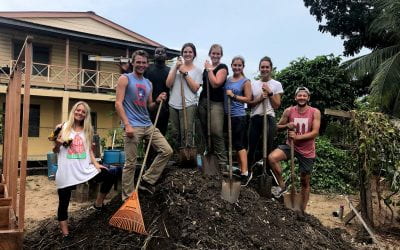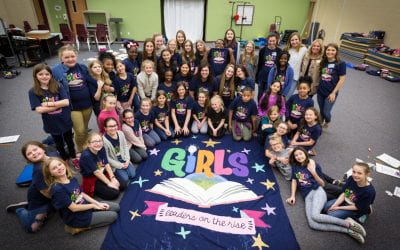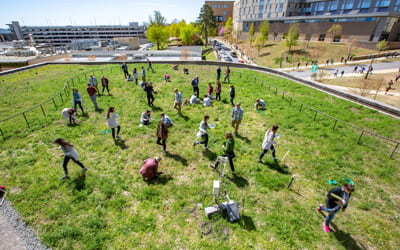On the Fashion of the Noldor in the First Age
By Samantha Kirby
Photos by Russell Cothren
Whether you’re a fan of Tolkien’s Middle Earth or have simply absorbed the cultural references it spawned (my precious…) you likely have a strong mental image of Tolkien’s characters. Galadriel, for example: Cate Blanchett, clad in white and silver, with flowing sleeves and Y-shaped fabric sash. Given the popularity of Peter Jackson’s film trilogy, that’s completely to be expected. But it’s also a problem, says Elkins native Grace Costello, who graduated in December 2018 with a degree in costume design from the Apparel Merchandising and Product Development program in the School of Human Environmental Sciences.
 “It’s all incredibly Eurocentric,” Costello explained. Because of Tolkien’s heavy influence in the fantasy genre, “these fashions have entered into the collective subconscious, especially after the Peter Jackson films.”
“It’s all incredibly Eurocentric,” Costello explained. Because of Tolkien’s heavy influence in the fantasy genre, “these fashions have entered into the collective subconscious, especially after the Peter Jackson films.”
Guided by faculty mentor Stephanie Hubert, Costello’s honors thesis reimagined the fashion trends of Tolkien’s Legendarium, deliberately avoiding this pre-Raphaelite, Eurocentric bias present in most mainstream visual representations of Middle Earth.
Costello said, “By changing the way we costume these people, we can change the way we see heroes in the collective subconscious.”
Costello focused on the Elven patterns of dress just before the creation of the Silmarils in the First Age, thousands of years before the events of The Lord of the Rings take place, when the High Elves are living in Valinor on Aman, a continent to the west of Middle Earth, across the sea. This point in time, Costello said, is “the peak of Elvish art and culture. The Elves have developed art and technology to this fantastic point, and they’re teetering on the brink of the darkening of Valinor, when, with the effects of war, migration and changing identity, fashion could go anywhere.” In addition, Costello said, Tolkien does not offer the reader detailed descriptions of Elvish dress during this period, but does provide in-depth information on Noldor language, culture and society. This allows plenty of room for informed interpretations of what Noldor dress might look like.
 Their interpretations led to the creation of two half-sized outfits, one for a male metalsmith and one for a female scholar. Importantly, the primary differences in the two designs rest not in gender but in their use and purpose, and, since the Noldor were a tribe of craftsmanship and practicality, the designs center around functionality. Both pieces are highly modular, for example, with overskirts or mantles that can be added or taken away to make the outfits more formal or more suitable to working.
Their interpretations led to the creation of two half-sized outfits, one for a male metalsmith and one for a female scholar. Importantly, the primary differences in the two designs rest not in gender but in their use and purpose, and, since the Noldor were a tribe of craftsmanship and practicality, the designs center around functionality. Both pieces are highly modular, for example, with overskirts or mantles that can be added or taken away to make the outfits more formal or more suitable to working.
For their designs, Costello used reds, blues, purples, silvers and golds, in fabrics including linen, silk velvet, silk charmeuse, silk chiffon, silk dupioni, and wool-silk blend brocade. “Silk is scarce in our world because it has to be imported from Asia,” Costello explained. “But silk is not scarce in Valinor – I don’t see any reason it would be. The climate would have been perfect for silk.”
And climate played a large role in Costello’s designs. The climate and geography of Cuiviénen, the birthplace of the Elves in northeastern Middle Earth, would have likely resembled the Uralic region of Europe, so Costello drew primarily from historical Finnish and Uralic dress when creating their initial patterns. The metalsmith’s tunic, for example, is a more traditional piece based on Khanty designs, sewn from rectangular and triangular pieces of fabric.
“By changing the way we costume these people, we can change the way we see heroes in the collective subconscious.”

More Field Notes
Model Garden to Boost Nutrition, Profits in Belize
A summer of beaches, tasty food, sunshine and a chance to serve. That’s the vision Zan Johnson, Bailey Carpenter, Natalie Zimmerman and Madison Ermert focused on as they tackled yet another pile of soil. Though the group anticipated unexpected adventures during the eight-week service-learning experience in Dangriga, Belize, they never dreamed of the sweat equity, sheer exhaustion and laughter that would accompany their journey.
Girl Power
Close to 40 fifth-grade girls are getting their ya-yas out as they try to maneuver an Oreo from forehead to open mouth – no hands allowed. The exercise invokes chaos, and more than a few cookies crushed underfoot, but the girls are quick to settle into a large circle anchored by Sophia Vincent, an honors education senior who easily commands the room.
Thin Tin
Two Honors College students have tackled – and solved – an important question about matter that sheds new light on the quantum world. Guided by mentor Salvador Barraza-Lopez, associate professor of physics, students Tyler Bishop and Erin Farmer have uncovered new information about tin oxide and have published their research in Physical Review Letters.
Rethinking Suburban Sprawl
David Sweere grew up in a classic American suburb in Maumelle, Arkansas, in a single-family home on a corner lot. He recalls a lot of lawn mowing and the fact that “you could see the Kroger grocery store from my house, but you couldn’t walk to it.” Fast forward through eight years of far-flung military service and six years of architecture school, and Sweere is ready to roll up his sleeves and redesign suburban sprawl.
Meet Rufus, Your Friendly Campus Green Roof
They’re strange bragging rights – but then again, it is a roof talking. And not just any roof – the U of A’s Hillside Auditorium green roof, which is exactly what it sounds like: a roof covered in about five inches of soil, atop which native plants have been growing since March 2013. The roof, affectionately dubbed “Rufus” by its student supervisors, has been tweeting measurement updates since early February 2019 via a Raspberry Pi microcomputer, thanks to senior Zack Wofford. Wofford was inspired by a tweeting tree he encountered while studying abroad in Ghent, Belgium.

Outfit for a male metalsmith draws on traditional Uralic and Finnish designs
But this environment is wholly different from the environment the Elves discovered in Valinor, which would have been significantly more temperate, with plentiful resources. “That’s where I got to let my imagination run wild,” Costello said. They were able to build upon this established fashion history to create something different. Even so, they said, “I wish I would have pushed it to be more alien,” by using techniques like weaving in the round, or by creating styles never-before-seen in the fashion world.
But with so much of the detailing to be done by hand, there just wasn’t enough time. They pick up the metalsmith’s linen-and-silk-chiffon undershirt. “This was hand-hemmed; the pin tucks, the arrowhead tacks, the button loops were all done by hand. The sleeves probably took three hours each to make.” Factor in the long preparatory process of ordering fabrics, creating patterns and cutting the cloth, and it clocks in at a lot of hours of work. “I started sewing winter break of 2017,” they recalled, “and was still gluing on crystals about an hour before my defense.”

Costello plans further embellishments to the overrobe for a female scholar
“The point is to show that you can’t just lock in” to a certain fashion history or design inspiration for fantasy worlds, Costello said. “Tolkien’s work comprises this huge, expansive world. There are so many ways you can interpret it.”
“What I don’t want is for this project to be a definitive guide to what elves wear,” they said. “Because it’s not. This is using my knowledge base, my own personal and aesthetic taste, and my background. All my education is overwhelmingly in European fashion history. I’d love to see other people from other cultural backgrounds make their own interpretations. I’d like to see a wider range of influences in mainstream media depictions and in academia, in Tolkien studies.”
Costello’s research and costume production was supported by Honors College Fellowship funding and an Honors College Travel Grant.









